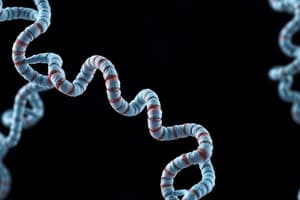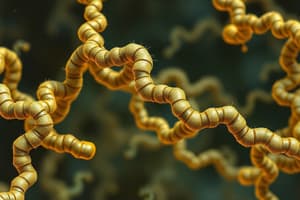Podcast
Questions and Answers
What structure of proteins refers to the sequence of amino acids in the polypeptide chain?
What structure of proteins refers to the sequence of amino acids in the polypeptide chain?
- Quaternary structure
- Tertiary structure
- Primary structure (correct)
- Secondary structure
Peptide bonds can be broken by conditions that denature proteins, such as heating.
Peptide bonds can be broken by conditions that denature proteins, such as heating.
False (B)
What are the two main forms of secondary structure in proteins?
What are the two main forms of secondary structure in proteins?
α-helix and β-pleated sheets
Prolonged exposure to a strong acid or base at elevated temperatures is required to hydrolyze peptide bonds non-enzymatically because these bonds are __________.
Prolonged exposure to a strong acid or base at elevated temperatures is required to hydrolyze peptide bonds non-enzymatically because these bonds are __________.
Match the type of protein structure with its description:
Match the type of protein structure with its description:
What is the main purpose of determining the amino acid composition of a polypeptide?
What is the main purpose of determining the amino acid composition of a polypeptide?
Which diseases are associated with abnormal amino acid sequences in proteins?
Which diseases are associated with abnormal amino acid sequences in proteins?
What is denaturation of proteins primarily characterized by?
What is denaturation of proteins primarily characterized by?
Denaturation of proteins affects the primary structure of proteins.
Denaturation of proteins affects the primary structure of proteins.
What is amyloid β (Aβ) and its significance in Alzheimer's disease?
What is amyloid β (Aβ) and its significance in Alzheimer's disease?
Misfolded proteins in the cell are usually tagged for _____ and degradation.
Misfolded proteins in the cell are usually tagged for _____ and degradation.
Match the following denaturing agents with their effects:
Match the following denaturing agents with their effects:
Which of the following is a characteristic of an α-helix?
Which of the following is a characteristic of an α-helix?
The β-pleated sheet structure is composed of only a single polypeptide chain.
The β-pleated sheet structure is composed of only a single polypeptide chain.
What type of interactions stabilize the tertiary structure of proteins?
What type of interactions stabilize the tertiary structure of proteins?
Proteins possess quaternary structure if they consist of two or more __________.
Proteins possess quaternary structure if they consist of two or more __________.
Match the type of protein structure with its description:
Match the type of protein structure with its description:
Which protein structure is abundant in hemoglobin?
Which protein structure is abundant in hemoglobin?
Hydrophobic interactions involve the attraction between similar charged side chains.
Hydrophobic interactions involve the attraction between similar charged side chains.
What happens to the amino acid side chains during protein folding?
What happens to the amino acid side chains during protein folding?
The core of a protein domain is built from combinations of __________.
The core of a protein domain is built from combinations of __________.
Which type of bonding only occurs between different polypeptide chains in quaternary structures?
Which type of bonding only occurs between different polypeptide chains in quaternary structures?
Flashcards are hidden until you start studying
Study Notes
Protein Structure and Functions
- Proteins are the most abundant and diverse molecules in living systems.
- Proteins are composed of amino acid residues linked by peptide bonds.
- Proteins have four levels of structural organization: primary, secondary, tertiary, and quaternary.
- The specific structure of a protein is essential for its biological function.
Primary Structure
- The primary structure of a protein is the sequence of amino acids in the polypeptide chain.
- Understanding the primary structure is crucial because genetic diseases often involve mutations that lead to abnormal amino acid sequences, causing misfolding and impaired protein function.
Peptide Bonds
- Peptide bonds are covalent bonds formed between the α-carboxyl group of one amino acid and the α-amino group of another.
- Peptide bonds are stable and not easily broken by denaturing conditions like heat or high urea concentrations.
- Strong acids or bases at elevated temperatures are required for non-enzymatic hydrolysis of peptide bonds.
Secondary Structure
- The secondary structure of a protein involves the coiling, folding, or bending of the polypeptide chain.
- There are two main types of secondary structure:
- α-helix: a rod-like structure with a spiral arrangement of the polypeptide chain.
- β-pleated sheet: a sheet-like structure composed of two or more polypeptide chains arranged in a folded, extended conformation.
- α-helices are abundant in proteins like hemoglobin and myoglobin, while β-pleated sheets are found in proteins like silk fibroin and carbonic anhydrase.
Tertiary Structure
- The tertiary structure of a protein refers to the folding of domains, which are fundamental three-dimensional units of polypeptides.
- Domains are built from combinations of supersecondary structural elements like α-helices and β-pleated sheets.
- Tertiary structure is stabilized by various interactions, including:
- Disulfide bonds
- Hydrophobic interactions
- Hydrogen bonds
- Ionic interactions
Quaternary Structure
- Proteins with quaternary structure consist of two or more polypeptide chains, also known as subunits or monomers.
- Subunits are held together by non-covalent interactions such as hydrogen bonds, ionic bonds, and hydrophobic interactions.
Protein Folding
- Protein folding is a complex process that occurs within cells, often in seconds to minutes.
- Folding is guided by interactions between amino acid side chains, including attractions between oppositely charged chains and repulsions between similarly charged ones.
- Hydrogen bonds, hydrophobic interactions, and disulfide bonds also influence protein folding.
- The folding process involves testing various configurations until a stable conformation is reached where attractions outweigh repulsions.
Denaturation of Proteins
- Denaturation refers to the loss of native structure and biological activity of proteins.
- Denaturing agents disrupt secondary, tertiary, and quaternary structures, causing the protein to unfold.
- The primary structure remains intact during denaturation because peptide bonds are not broken.
- Common denaturing agents include:
- Heat
- Organic solvents
- Strong acids or bases
- Detergents
- Heavy metal ions (e.g., lead, mercury)
Protein Misfolding
- Protein folding is a complex process that can sometimes result in misfolded proteins.
- Misfolded proteins are usually tagged and degraded within the cell by quality control systems.
- Accumulation of misfolded proteins is associated with several diseases.
Amyloid Diseases
- Amyloid diseases involve the accumulation of insoluble, spontaneously aggregating proteins called amyloids.
- Amyloid formation can occur spontaneously, due to mutations in genes that produce altered proteins, or by abnormal proteolytic cleavage of proteins.
- Amyloids are often composed of fibrillar protein assemblies consisting of β-pleated sheets.
- Amyloids are implicated in various degenerative diseases, particularly age-related neurodegenerative disorders like Alzheimer's disease.
Alzheimer's Disease
- Alzheimer's disease is characterized by amyloid plaques, which are aggregates of amyloid β (Aβ) peptides.
- Aβ is a peptide containing 40-42 amino acid residues.
- The aggregation of Aβ in a β-pleated sheet configuration is neurotoxic and contributes to the cognitive impairment associated with Alzheimer's disease.
Studying That Suits You
Use AI to generate personalized quizzes and flashcards to suit your learning preferences.




